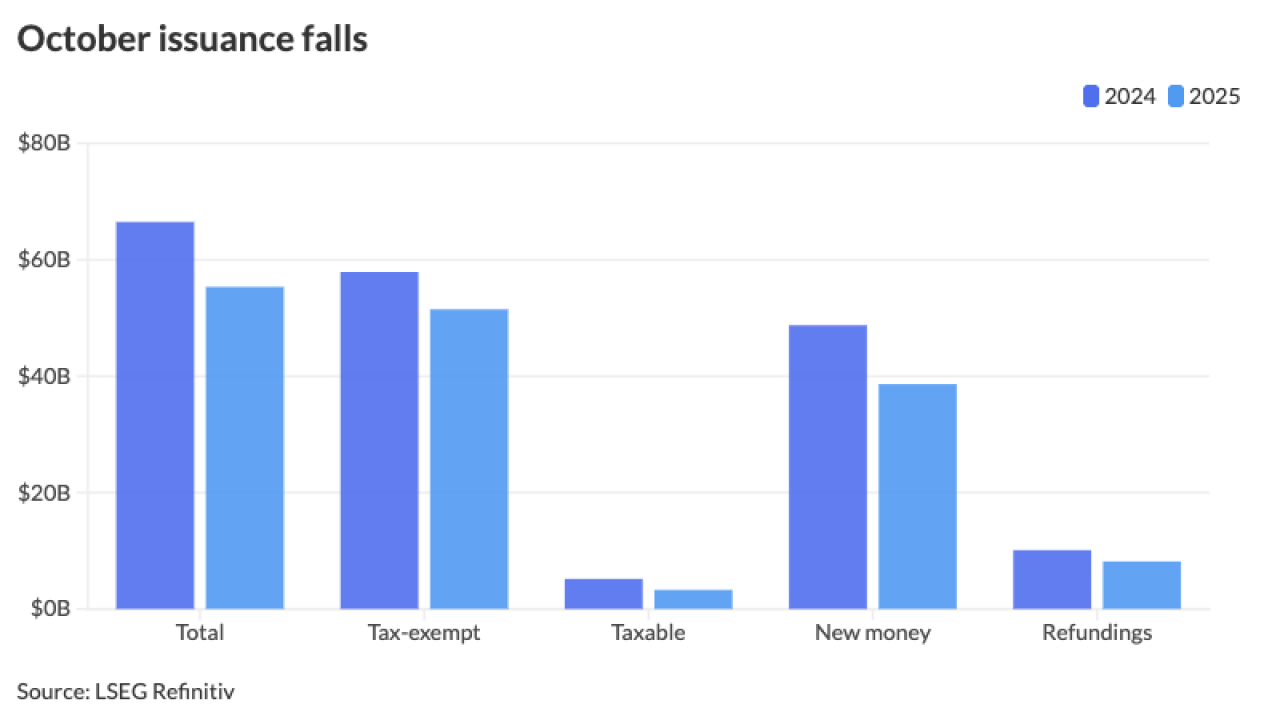Municipal bond issuance declined year-over-year for the third consecutive month, as supply moderated compared to the surge in issuance in October 2024, when market participants issued bonds in order to avoid potential election-related volatility.
October volume was $55.348 billion, down 16.8% from $66.513 billion in 2024. However, this is still above October's 10-year average of $49.033 billion.
Issuance year-to-date is $493.063 billion, up 9.3% from $451.079 billion over the same period. With next week's issuance estimated at $13.118 billion, volume is likely to surpass 2024's $513.652 billion record by the middle of November.
"Despite a softer October, supply has been sprinting ahead of record levels all year. And by any measure, $55 billion is substantial, especially considering last October was enormous," said James Pruskowski, an investor and market strategist.
Issuance was robust in October 2024, the heaviest month of that year, as issuers flocked to market ahead of potential election-related volatility and to avoid possible problems tapping the capital markets through yearend, said Jamie Iselin, head of the municipal fixed income team and a senior portfolio manager at Neuberger Berman.
Therefore, it's unsurprising that issuance fell in October 2025 — which was still a decent month for supply — from the mass influx of supply last year, he said.
October saw uneven issuance. Some weeks saw elevated volume, including the second-to-last week of the month, which recorded $16 billion in tax-exempt issuance — the fifth-largest on record, according to J.P. Morgan strategists.
However, others, like the final week of the month, saw lower issuance due to the Federal Open Market Committee meeting. Iselin was surprised that some of the bigger deals from the first week of November, including the largest prepaid gas deal ever, with $2.7 billion in energy supply revenue bonds from the Southeast Energy Authority, did not try to "pull" themselves up a week to take advantage of the smaller calendar.
The dip in issuance in October was not "about fading demand; it was about issuers choosing not to price into chaos," Pruskowski said.
"Washington's shutdown, geopolitical shockwaves, and a Treasury market that whipsawed on every headline turned October into a no-fly zone for public finance officers," he said. "Volatility is the enemy of execution, and in October it was running the show."
Then there is also the off-year election cycle, where market participants do not want a "billion-dollar bond deal competing with campaign flyers," so a "tactical pause, not a structural shift," ensues, Pruskowski said.
"The fundamentals haven't changed. Issuers are staring at aging infrastructure, waning federal incentives, and a favorable financing window. The pipeline is long, the demand base is deep, and the run into yearend is poised to heat back up quickly," Pruskowski said.
October details
Tax-exempt issuance fell 11.1% to $51.497 billion in 786 issues from $57.905 billion in 1,059 issues a year ago. Taxable issuance dropped 36.5% to $3.284 billion in 57 issues from $5.171 billion in 97 issues in 2024. AMT issuance was $566.5 million, down 83.5% from $3.437 billion in 2024.
New-money issuance fell 20.8% to $38.63 billion from $48.765 billion, while refundings were down 19.2% to $8.172 billion from $10.114 billion.
Revenue bond issuance dropped 13.7% to $37.508 billion from $43.476 billion in October 2024, and general obligation bond sales decreased 22.6% to $17.84 billion from $23.037 billion in 2024.
Negotiated deal volume was down 10.6% to $46.561 billion from $52.094 billion a year prior. Competitive sales fell 31.7% to $8.745 billion from $12.813 billion in 2024.
Bond insurance decreased 56.3% to $3.326 billion from $7.606 billion.
Bank-qualified issuance fell 32.7% to $686.2 million in 162 deals from $1.019 billion in 263 deals a year prior.
Texas claimed the top spot year-to-date among states.
Issuers in the Lone Star State accounted for $73.153 billion, up 21.3% year-over-year. California was second with $71.578 billion, up 10.5%. New York was third with $55.953 billion, up 4.6%, followed by Florida in fourth with $20.029 billion, down 19.1%, and Wisconsin in fifth with $15.676 billion, a 56.6% increase from 2024.
Rounding out the top 10: Massachusetts with $15.322 billion, up 17.5%; Pennsylvania with $14.657 billion, down 3.5%; Illinois with $13.038 billion, down 7.2% Alabama with $12.7 billion, up 11.7%; and Washington with $12.092 billion, down 5.2%.





